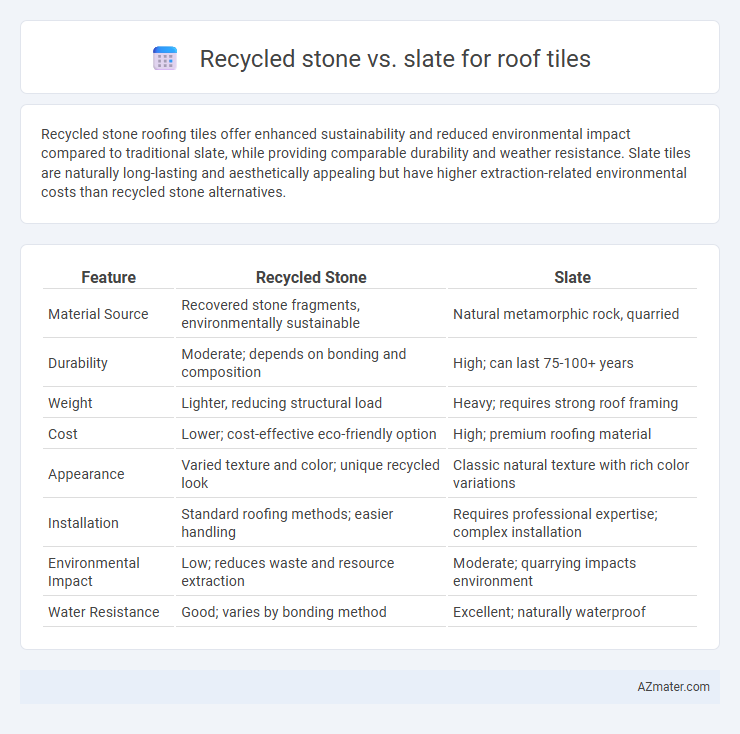Recycled stone roofing tiles offer enhanced sustainability and reduced environmental impact compared to traditional slate, while providing comparable durability and weather resistance. Slate tiles are naturally long-lasting and aesthetically appealing but have higher extraction-related environmental costs than recycled stone alternatives.
Table of Comparison
| Feature | Recycled Stone | Slate |
|---|---|---|
| Material Source | Recovered stone fragments, environmentally sustainable | Natural metamorphic rock, quarried |
| Durability | Moderate; depends on bonding and composition | High; can last 75-100+ years |
| Weight | Lighter, reducing structural load | Heavy; requires strong roof framing |
| Cost | Lower; cost-effective eco-friendly option | High; premium roofing material |
| Appearance | Varied texture and color; unique recycled look | Classic natural texture with rich color variations |
| Installation | Standard roofing methods; easier handling | Requires professional expertise; complex installation |
| Environmental Impact | Low; reduces waste and resource extraction | Moderate; quarrying impacts environment |
| Water Resistance | Good; varies by bonding method | Excellent; naturally waterproof |
Introduction to Roofing Materials: Recycled Stone vs Slate
Recycled stone roofing offers an eco-friendly alternative to traditional slate, utilizing crushed natural stone bound with resin to mimic slate's aesthetic and durability. Slate roofing, valued for its natural beauty and long lifespan of up to 100 years, provides fire resistance and minimal maintenance, making it a premium choice in roofing materials. Both materials deliver strong weather resistance, but recycled stone tiles often come at a lower cost and with a reduced environmental footprint compared to quarried slate.
Environmental Impact: Sustainability and Eco-Friendliness
Recycled stone roof tiles significantly reduce landfill waste by repurposing materials, lowering the demand for new raw extraction compared to slate tiles, which require quarrying and result in habitat disruption. The energy consumption and carbon emissions associated with manufacturing recycled stone are considerably lower than the intensive processes involved in slate extraction and shaping. Utilizing recycled stone promotes circular economy principles and minimizes environmental footprints, making it a more sustainable and eco-friendly choice for roofing materials.
Durability and Longevity of Recycled Stone vs Slate Tiles
Recycled stone roof tiles offer notable durability, often resisting weathering, cracking, and erosion thanks to their composite material structure. Slate tiles, composed of natural metamorphic rock, are renowned for exceptional longevity, frequently lasting over a century with minimal maintenance due to their dense, layered mineral composition. While slate provides unparalleled lifespan and natural weather resistance, recycled stone tiles present a sustainable alternative with competitive durability, particularly in modern roofing applications prioritizing environmental impact.
Cost Comparison: Upfront and Long-Term Expenses
Recycled stone roof tiles typically have a lower upfront cost compared to natural slate, making them an attractive option for budget-conscious projects. Over the long term, slate offers exceptional durability and can last over a century, reducing replacement frequency and maintenance expenses, whereas recycled stone may require more frequent repairs. When evaluating total cost of ownership, recycled stone provides initial savings but slate's longevity often results in lower overall expenses across decades.
Installation Process: Ease and Requirements
Recycled stone roof tiles typically require standard roofing tools and can be installed by experienced roofers with moderate effort due to their consistent size and weight. Slate tiles, known for their natural variability and fragility, demand skilled installers and specialized equipment to handle precise cutting and secure fastening, increasing installation complexity. Both materials benefit from proper underlayment and support structures, but slate's higher fragility necessitates more careful handling to prevent breakage during installation.
Aesthetic Appeal: Texture, Color, and Style Options
Recycled stone roofing tiles offer a unique, eco-friendly aesthetic with varied textures and earthy color palettes that blend naturally into landscapes, providing a rustic charm. Slate roof tiles boast a classic elegance with smooth, fine-grained textures and a range of rich, deep hues like gray, green, and purple, enabling sophisticated and timeless architectural styles. Choosing between recycled stone and slate depends on the desired visual impact, with recycled stone emphasizing sustainability and organic variation, while slate delivers enduring beauty and refined style options.
Maintenance Needs and Weather Resistance
Recycled stone roof tiles require minimal maintenance due to their durable composition and resistance to chipping, while slate tiles need periodic inspections to address potential cracking or delamination. Slate exhibits superior weather resistance, with a natural ability to withstand extreme temperatures, heavy rainfall, and freeze-thaw cycles, whereas recycled stone offers good but slightly lower resistance to moisture infiltration. Both materials provide long-lasting roofing solutions, but slate's natural mineral density typically ensures enhanced longevity in harsh weather conditions.
Weight and Structural Considerations
Recycled stone roofing tiles typically weigh less than traditional slate, reducing the overall load on the roof structure and potentially lowering installation costs. Slate is denser and heavier, often requiring reinforced roof framing to support its substantial weight, which can increase structural expenses. Selecting between recycled stone and slate for roof tiles hinges on evaluating existing roof support capacity and long-term durability requirements.
Market Availability and Sourcing
Recycled stone roofing tiles are gaining traction in sustainable building markets due to their eco-friendly sourcing from reclaimed materials, yet their availability remains limited and region-specific compared to slate. Slate tiles boast widespread market availability and reliable sourcing from established quarries, ensuring consistent quality and supply for roofing projects globally. The higher cost and environmental benefits of recycled stone influence buyer decisions, while slate retains dominance due to its proven durability and extensive distribution networks.
Conclusion: Which Roofing Tile Is Right for You?
Recycled stone roof tiles offer superior sustainability, durability, and eco-friendliness, making them ideal for environmentally conscious homeowners seeking longevity and reduced carbon footprint. Slate roof tiles provide unmatched natural beauty, excellent fire resistance, and a classic aesthetic but come at a higher cost and require skilled installation. Choosing between recycled stone and slate depends on your budget, environmental priorities, and desired roof appearance, with recycled stone excelling in cost-effectiveness and sustainability while slate stands out for timeless elegance.

Infographic: Recycled stone vs Slate for Roof tile
 azmater.com
azmater.com